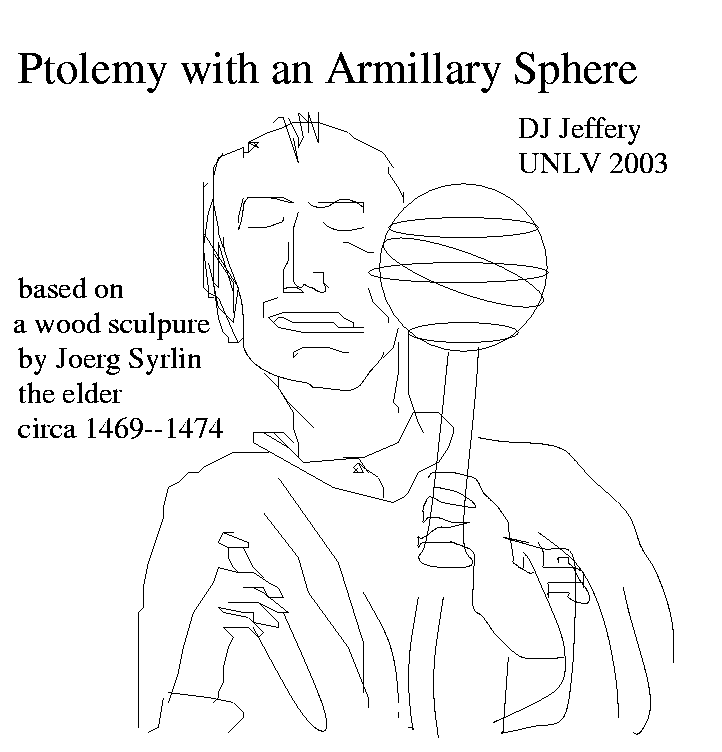
Caption: Ptolemy (c.100--c.170 CE) with an armillary sphere.
-
Mortal as I am, I know that I am born for a day.
But when I follow at my pleasure the serried multitude of the
stars in their circular course,
my feet no longer touch the Earth.
-
---Ptolemy (c.100--c.170 CE):
quotation from
goodreads: Quotes: Ptolemy.
Features:
- Ptolemy is arguably the greatest of
the ancient Greek astronomers.
- Among many other things, Ptolemy
wrote up a star catalogue
(i.e., the
Ptolemaic catalogue of 1022 stars)
in his book the
Almagest (c.150 CE)
(Wikipedia: Almagest:
The star catalogue).
There were 1022 stars mostly located
in the
Ptolemaic 48 constellations
many of which constellations
are in the modern
IAU 88 constellations.
Many, maybe all, the
Ptolemaic 48 constellations
had been known before
Ptolemy though probably NOT
completely defined
(Wikipedia:
Constellation: Early modern astronomy).
Some may be very ancient: e.g.,
constellation
Taurus might go back to
to circa 15,000 BCE
(Wikipedia:
Taurus: History and mythology).
- In the
Ptolemaic catalogue of 1022 stars,
Ptolemy
listed 6 cloudy
stars
(plus one cloudy object NOT associated with any
star)
(No-113,402;
Wikipedia: Nebula:
Observational history;
SEDS: Ptolemy (about 85-165 AD)).
In ancient Greek, the word Ptolemy used for the cloudy objects was "nephele" which became a loanword in Latin as nebula (Latin for cloud or fog). Note nebula (L.) = nephele (G.) = νηφηλη (G. letters).
Note, Ptolemy may NOT have been the original discoverer of nebulae, but he is the first person in the historical record to mention them. Maybe some earlier ancient Greek astronomer or some Babylonian astronomer or someone ever further back (maybe even in the Paleolithic (c.3.3 Myr--c.11,700 BCE)) was first.
- So in scientific method terms,
there were observations of ordinary
stars
and observations of nebulae.
But what was the theories for both. Time would tell. A very long time.
- The crude sketch in the image is based on
a wood scuplture by
Joerg Syrlin the Elder (c.1425--1491)
that was made circa
1469--1474.
The wood scuplture is in the
choir stalls of
Ulm Minster,
Ulm,
Germany.
An image of the original and better description can be found at the
Ptolemy iconography site
of Robert Derome,
University de Quebec
a Montreal.
- See Ptolemy videos
below
(local link /
general link: ptolemy_videos.html):
- EOF
Image link: Itself.
Local file: local link: ptolemy_armillary.html.
File: Ptolemy file: ptolemy_armillary.html.